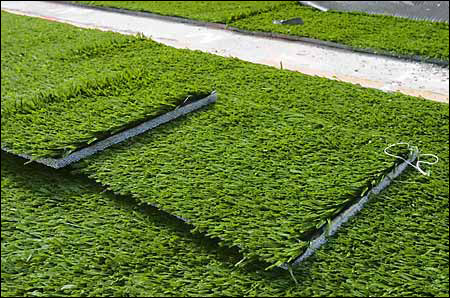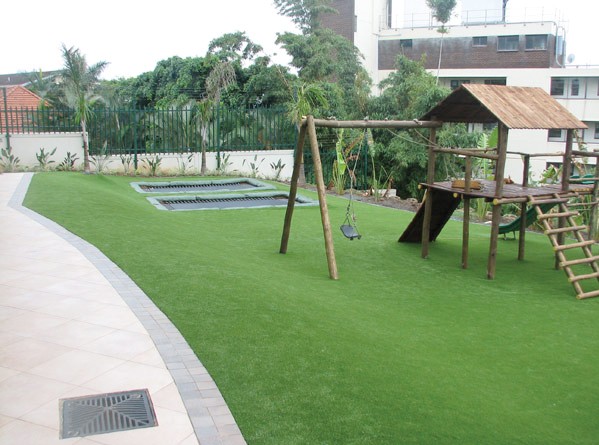Advantages
Artificial turf can be a better solution when the environment is particularly hostile to natural grass. An arid environment or one where there is little natural light are examples.
Artificial turf can withstand significantly more use than natural grass and can therefore be used much more frequently. This allows sports ground owners to generate more income from their facilities.
Ideal for holiday homes when maintenance of lawns is not practical. It is also a solution for elderly home-owners who find the upkeep of lawns too much hard work. Artificial turf can be vacuumed, broom cleaned or hosed over.
Suitable for roof gardens and swimming pool surrounds.
Some artificial turf systems allow for the integration of fiber-optic fibers into the turf. This would allow for lighting or advertisements to be directly embedded in a playing surface, or runway lighting to be embedded in artificial landing surfaces for aircraft.

Disadvantages
Some artificial turf requires infill such as silicon sand and/or granulated rubber. Some granulated rubber is made from recycled car tires and may carry heavy metals which can leach into the water table. Alternative sources of infill may provide a safer solution.
There is some evidence that periodic disinfection of artificial turf is required as pathogens are not broken down by natural processes in the same manner as natural grass. Despite this, a 2006 study suggests certain microbial life is less active in artificial turf.
Friction between skin and older generations of artificial turf can cause abrasions and/or burns to a much greater extent than natural grass.This is an issue for some sports: for example, football in which sliding maneuvers are common and clothing does not fully cover the limbs. However, some third-generation artificial grasses almost completely eliminate this risk by the use of polyethylene yarn.
Artificial turf tends to retain heat from the sun and can be much hotter than natural grass with prolonged exposure to the sun.[18] This can be reduced by the application of water prior to use of the playing field.
In comparison with earlier generations of artificial turf, modern turfs are more permanent installations and are not as easily removed and replaced for individual sports. For instance, with earlier generations of turf, a multi-purpose stadium could have one turf set up for American football, roll it up, and replace it with a turf for, for instance, baseball or soccer. With sand and/or rubber infill and some solutions adopted for fixing the artificial turf, modern artificial turf installations do not lend themselves to easy removal. This is part of the reason why short-pile turfs remain in use in indoor American football, which shares arenas with hockey and basketball teams, requiring easy removal of turf when the game is finished.
Line markings for differing sports are sewn into artificial turf, making line markings permanent. In most cases with natural grass, line markings can be painted on with temporary paint and removed (washed away) or it dissipates with rain or general irrigation. Line markings in artificial turf for multiple sports are achieved by sewing in contrasting colours during production or 'cutting in' during installation. This creates a cluttered appearance and is usually unacceptable for professional sports. (Prior to the adoption of modern turfs, there were five stadiums hosting both MLB and NFL teams; as of 2012, there will only be one, and there has also been a rise in soccer-specific stadiums in this time frame.) Temporary line marking solutions for artificial turf have not yet been adopted.





